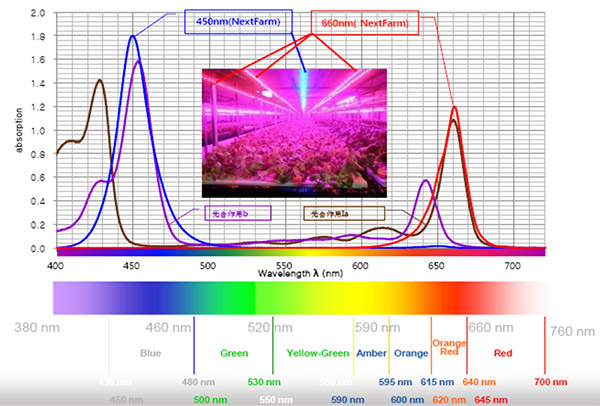How does the Sunlight Affect Plant Growth?
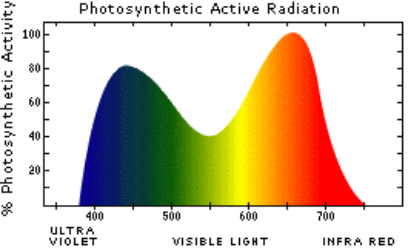
| 200-280nm | UVC ultraviolet range which is extremely harmful to plants because it is highly toxic. |
|---|---|
| 280-315nm | Includes harmful UVB ultraviolet light which causes plants colors to fade. |
| 315-380nm | Range of UVA ultraviolet light which is neither harmful nor beneficial to plant growth. |
| 380-400nm | Start of visible light spectrum. Process of chlorophyll absorption begins. UV protected plastics ideally block out any light below this range. Positive Effects of UV Light on Plants. UV light assists in directing the architectural growth of a plant. It does this by eradicating or limiting certain hormones in the plant. UV light also boosts the plant's immunity to pests and harmful bacteria. Negative Effects of UV Light on Plants. The lower frequencies of UV light will cause severe radiation poisoning within the plant, resulting in loss of color, stunted or deformed growth or death. The Finnish Meteorological Institute says the ozone layer protects life on Earth from excessive UV radiation. Effects of Blocking UV on Plants. In 2009, Diane L. Polyakov submitted a project to the California State Science Fair showing the effects of UV light on pea plants. The conclusion showed that blocking UV light does help the plant to grow, but also deprives the plant of essential nutrients used to combat mold. |
| 400-520nm | This range includes violet, blue, and green bands. Peak absorption by chlorophyll occurs, and a strong influence on photosynthesis. (promotes vegetative growth) |
| 520-610nm | This range includes the green, yellow, and orange bands and has less absorption by pigments. |
| 610-720nm | This is the red band. Large amount of absorption by chlorophyll occurs, and most significant influence on photosynthesis. (promotes flowering and budding) |
| 720-1000nm | There is little absorption by chlorophyll here. Flowering and germination is influenced. At the high end of the band is infrared, which is heat. |
| 1000+ nm | Totally infrared range. All energy absorbed at this point is converted to heat. |
The wavelength that plant utilize most
Plants have two kinds of chlorophyll - A and B.We can see from the above charts that Chlorophyll has two spectral ranges of utilization - red (around 635-670nm) and blue (around 430-470nm).
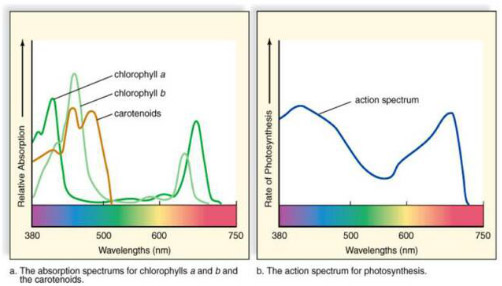
Ultraviolet light (10nm-400nm)
Though overexposure to UV light is dangerous for the flora, small amounts of near-UV light can have beneficial effects. In many cases, UV light is a very important contributor for plant colors, tastes and aromas. This is an indication of near-UV light effect on metabolic processes. Studies show that 385 nm UV light promotes the accumulation of phenolic compounds, enhances antioxidant activity of plant extracts, but does not have any significant effect on growth processes.
Blue light (430nm-450nm)
This range of spectrum enables cryptochromes and phototropins to mediate plant responses such as phototropic curvature, inhibition of elongation growth, chloroplast movement, stomatal opening and seedling growth regulation. It affects chlorophyll formation, photosynthesis processes, and through the cryptochrome and phytochrome system, raises the photomorphogenetic response. In more practical terms, these wavelengths encourage vegetative growth and are essential in lighting for seedlings and young plants during the vegetative stage of their growth cycle, especially when "stretching" must be reduced or eliminated. It also stimulates the production of secondary pigments which can enhance colors and is known to also stimulate Terpene (i.e. fragrance) production.
Green light (500nm-550nm)
Most green light is reflected off the plant and plays a much smaller role in plant growth. However, there are some important aspects of light in this range so a certain amount of light in this spectrum range is beneficial. Green light is sometimes used as a tool for eliciting specific plant responses such as stomatal control, phototropism, photomorphogenic growth and environmental signaling. When combined with blue, red and far-red wavelengths, green light completes a comprehensive spectral treatment for understanding plant physiological activity. The function of green light is less well understood than the other spectrums, and there are only certain species of plants that require green light for normal growth. It's effects appear to be very strain specific. The pigments that can absorb green are found deeper in the leaf structure so it is thought that because green light reflects off of the Chlorophyll in leaf surfaces and thus is reflected deeper into the shaded areas of the canopy than Red and Blue which are readily absorbed, that green may actually be mostly absorbed through the undersides of the leaves as it bounces around in the shaded depths of the canopy.
Red light (640nm-680nm)
Red light affects phytochrome reversibility and is the most important for flowering and fruiting regulation. These wavelengths encourage stem growth, flowering and fruit production, and chlorophyll production. The 660nm wavelength has a very strong photosynthetic action and also exhibits the highest action on red-absorbing phytochrome regulated germination, flowering and other processes. Most effective for light cycle extension or night interruption to induce flowering of long-day plants or to prevent flowering of short-day plants.
Far red (730nm)
Although the 730nm wavelength is outside the photosynthetically active range, it has the strongest action on the far-red absorbing form of phytochrome, converting it back to the red-absorbing form. It becomes necessary for plants requiring relatively low values of the phytochrome photoequilibrium to flower.
Sun light analysis:
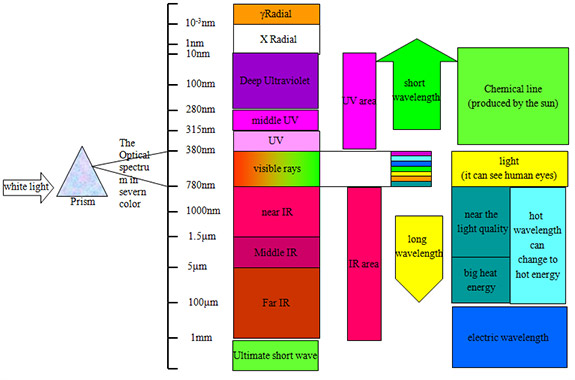
led spectrum ananlysis:
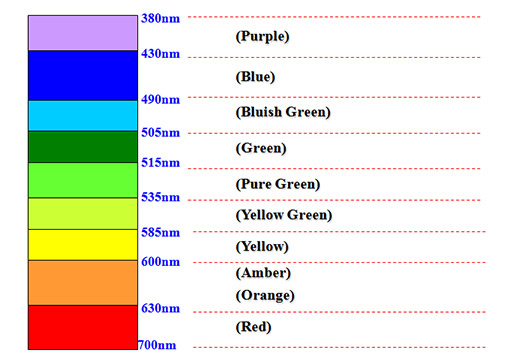
Photosynthetic analysis:
